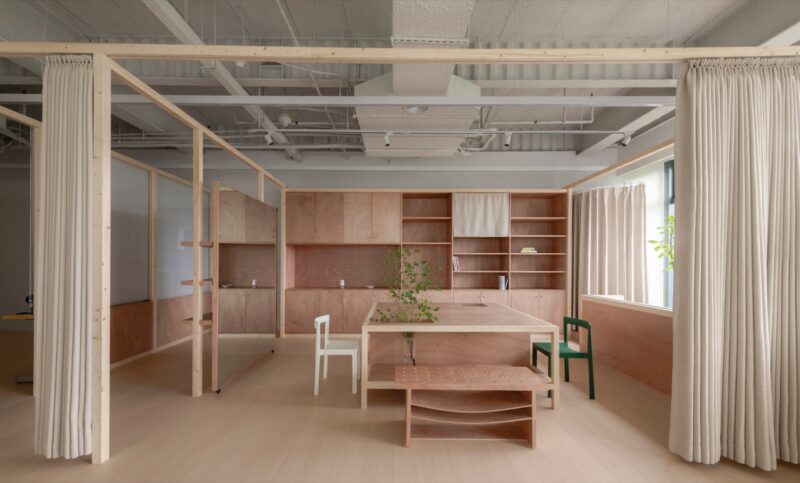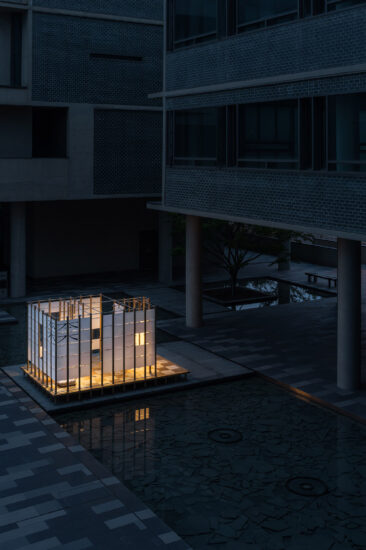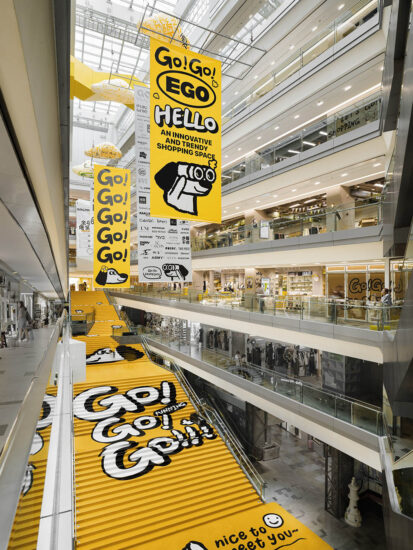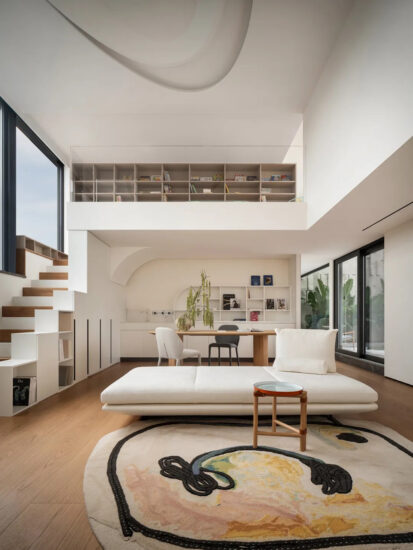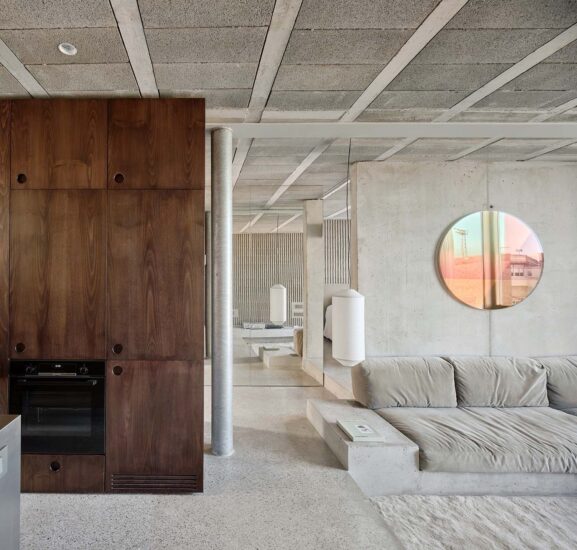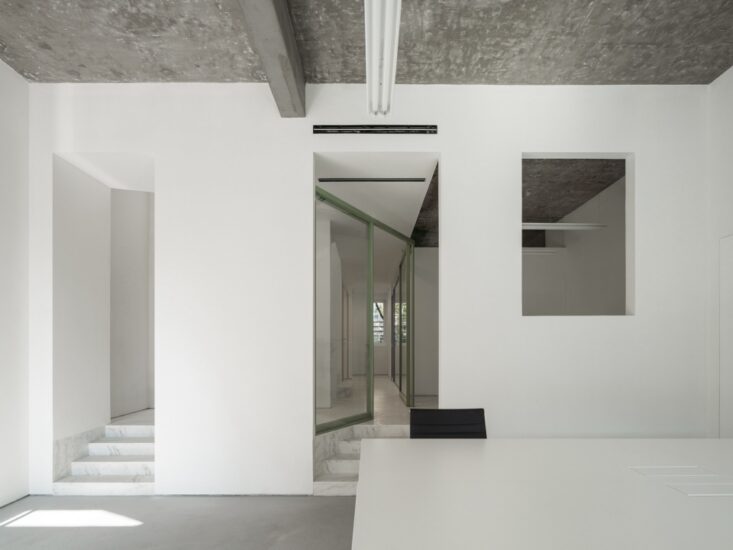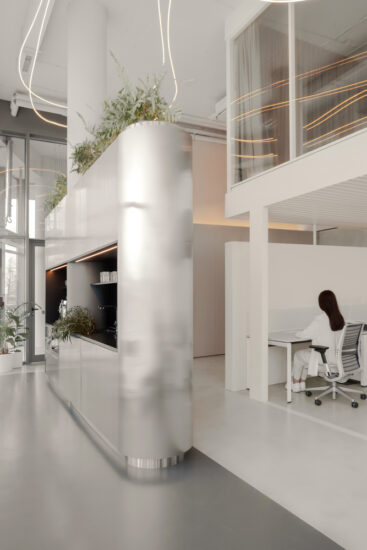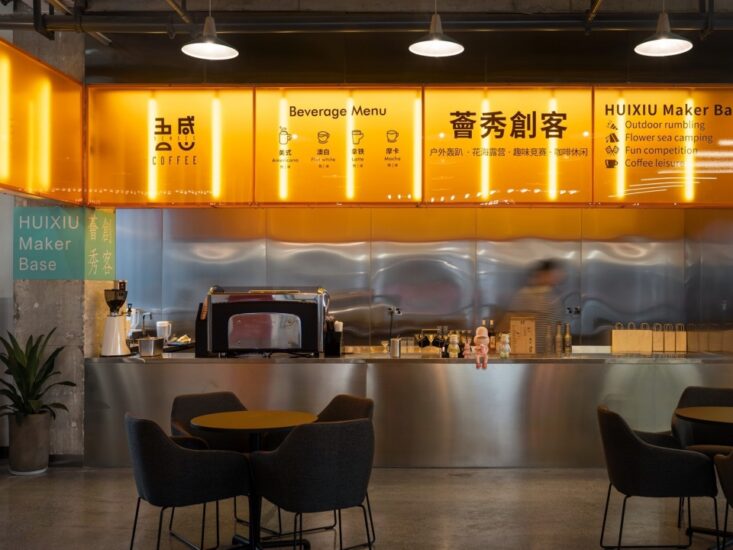The client has rented two floors in a high-rise tower in the city centre of Chengdu, China and asked AND lab to design the lower floor, which shall house the administration level of about 80 staffs. This lower floor serves as a floor for the client to receive corporate guest, to interview new candidates and to train new staffs, while the upper floor is the operating floor of its call center business.
客户在成都市中心的一个高楼里租了两个楼层并请纳间建筑设计其中的下层,它将容纳大约80个行政层级人员的办公。这下层也是一个客户接待企业客户,面试新应聘者及培训新员工的楼层,而上一层则是其呼叫中心业务的运作楼层。
As AND lab approached the project, Clarence Chia figured that the Modern typology of office has not evolved much for the past decades. The management level’s office rooms are still forming a row along façade blocking the sunlight while other employees are sitting in the open office. The problem is not about the hierarchy but the rooms are laid in a row, in a way that they blocked all the sunlight, view and fresh air. He thinks that the hierarchy system in a corporate should not restrained some of workers’ rights to access natural resources, hence, the team went through a search for a non-authoritarian open plan while protecting the interests of all parties. AND lab approached this project like a micro-urban planning and micro-architecture.
当纳间切入这个项目时,谢典杉认为在过去几十年里现代类型的办公室并没有太大的演变。管理层的办公室依旧沿着幕墙形成一排挡着阳光而其他员工则坐在开敞办公区。问题不是阶级而是房间排成一排,某种程度上它们挡着了所有阳光,视野及新鲜空气。他认为企业的阶级系统不应该限制一些员工获得自然资源的权利。因此团队在保护各方利益的同时,寻找一个非专制的开放平面。于是纳间建筑把这个项目当作是个微型城市规划或微建筑来切入。
Paradigm Shift 范式转变
The designer first breaks the required functions into smaller sizes and also the bonds between rooms so that rooms are no longer laid in a row, then they borrow the idea of multi-centers in urban planning to re-group and re-distribute repetitive functions into centers then scatter them throughout the floor. For example, instead of conventional way of having single area for pantry, printing area and meeting rooms, many tiny pantries, printing and discussion corners are allocated, emphasizing on adjacency for different teams of staffs and failover availability and also encouraging staffs’ interaction.
设计师首先将所需的功能分解成更小的尺寸,也打破房间之间的“键”以便房间不再排成一排,然后借用城市规划里的多中心的思想,将重复性的功能重新分配组合成中心,然后将它们散落在整个楼层。 例如这里没有传统式单一区域给茶水间,打印区和会议室,而是有很多小的茶水间,打印区及讨论的角落,强调对于不同团队员工邻近性及故障替代的可用性并鼓励员工间的互动。
Micro-urban in the sky 空中城市
While avoiding the monotonous spatial quality within a high-rise and trying to bring in some urban spatial qualities, the team decided to group spaces organically to form lobes, which in turn organically re-define and reshape the circulation and the open space, around the core like cells. So that when one moves across spaces, he or she is either bathed under the sunlight or expecting sunlight at the ends. On top of that, no matter at which corner the person is, he or she is always connected with the city, seasons and time.
在避免高层建筑中的单调空间并尝试引入一些都市空间感的同时,设计团队决定将空间有机地分组形成“团”,从而有机地重新定义和重塑流线及敞开空间,像细胞一样围绕核心。这样一来,当员工在空间中移动时,他要么沐浴在阳光下或是期待在尽头阳光。最重要的是,无论在哪个角落,员工总是与城市、季节和时间联系在一起。
∇ 平面图
There are two entrances into space as required by client to split different groups of people, i.e. client, staffs, trainees and visitors to its subsidiaries.
At the second entrance for subsidiaries, AND lab designed a floating reception cantilevering for more than 4m.
客户要求两个进入空间的入口,以分散不同的人群,如客户、员工、实习生和其子公司的访客。
在供子公司用的第二入口,纳间建筑设计了一个超过4米的浮动接待台。
∇ 子公司入口的前台
At the other ends of the lift lobby is the main entrance to the office. After the main entrance, there is a reception area, where an enclosed VIP room was placed, in one hand, to prevent direct view into the space, on the other hand, it also diverts the flow between guests for meeting and staffs.
电梯大厅的另一端是办公室的主入口。在正门之后,有一个接待区,在那里放置了一个封闭的贵宾室,一方面确保不会望穿开放空间,另一方面,它可以分开来开会的访客与员工。
∇ 主入口的贵宾会议室及等候区
The VIP meeting room is in a form of a trimmed cone, which gradually opens up towards the windows.
贵宾会议室是一个逐渐向幕墙打开,斜切的圆锥体。
∇ 办公区通往入口
∇ 贵宾会议室
After the reception area, the HR division is allocated, accompanying with some interview rooms. The HR division will interview quite a number of interviewees daily, according to client.
经过接待空间后,设置了人力资源部门与面试间。根据客户描述人力资源部门每日会有较多场次的面试。
∇ 人事部与面试室
∇ 人事部的面试室
After the HR division, it is the restricted office zone.
人力资源部门后是受控制的办公区域。
The building’s floors and its lift lobbies are split into high and low zone. As the project located in the low zone and occupies whole floor, there is wide corridor, where it is meant to be lift lobbies for high zone’s floors.
这建筑的楼层及其电梯厅分成了高楼层与低楼层。因为项目位于低楼层并占了整层的面积,所以通往高楼层的电梯厅的位置在此层成为了一个很宽的走道。
∇ 装修前公区走道
∇ 大茶水间入口外办公区
This wide corridor is turned into a central pantry, linking the north and south office area.
这个很宽的走道被改成了一个中央茶水间。
∇ 大茶水间
Outside the entrance of the central pantry, the team designed an open casual discussion area.
在中心茶水间入口外边设计团队设计了一个非正式的开放讨论区。
∇ 大茶水间入口外休息座位
Along the open office area, discussion area, printing area and small pantries are evenly distributed. In the open office area, double ceiling is created and soft diffused reflected cove light is used as main lighting.
沿着开放办公区域,讨论区域,打印区域,以及小型的茶水间被均匀的布置了。纳间建筑设计了双层天花并使用了隐藏灯源的柔性慢反射光做主照明。
∇ 讨论区及开敞办公区
∇ 大茶水间入口外的小会议室
On the other hand, on the west side and right after the reception area, the meeting rooms and training rooms are allocated.
另一方面,在西侧及紧接接待区后,设置了会议室与培训室。
∇ 主入口等候区
A large meeting room is placed like a box within the space, sitting back from the façade so as not to blocking the sunlight and view from coming into the interior. And it is divisible into two smaller meeting rooms by removable partitions.
在这个空间中设计师放置了一个较大盒子作为会议室,并把它从幕墙一侧后退,以确保不会阻挡自然光照与望向外的视野。这个空间可由移动的隔墙的分割成为两个较小的会议室。
∇ 大会议室
∇ 大会议室外休息区
The area outside the large meeting room can be used as a waiting area before the meeting or training starts.
在大会议室外的区域可以用作会议或培训开始前的等待区域。
∇ 大会议室外休息区
Behind the large meeting room, is a training room, which can also be divided into two smaller training rooms, so as to hold training class for different groups simultaneously.
在大会议室后是培训室,培训室也可以被分为两个较小的培训室,以便进行不同组的培训课。
∇ 大培训室外
Just like the meeting room, the training room is also setting back from the façade, creating a bright and well-ventilated access back to the restricted office zone.
就像会议室一样,培训室也从建筑幕墙后退,创造出一个回到员工办公区域的明亮,通风的交通空间。
∇ 大培训室外走道
∇ 子公司办公区
项目信息
项目名称:万声西南城市总部
设计公司:AND lab 纳间建筑设计咨询(北京)有限公司
官网:www.andlab.sg
联系邮箱:contact@andlab.sg
完成年份:2022
建筑面积:1625.66 平米
项目位置:成都市成华区成华大道杉板路669号招商中央华城3期
摄影师:聿空间/刘伟
结构师:C2 CONSULTING ENGINEERS
设计团队:谢典杉Clarence Chia,赵径真,杨烁,潘祺辉,张诚,刘敬一
宣传员: Foong Chern Wong
甲方:山东万声置业有限公司
项目中使用产品 品牌:Gabriel,杜邦;办公家具:Herman Miller


























